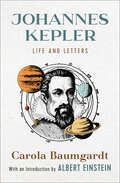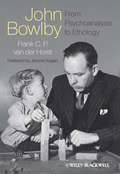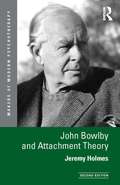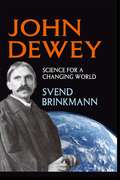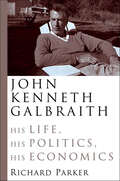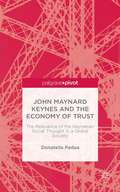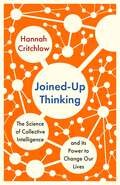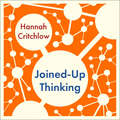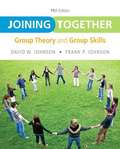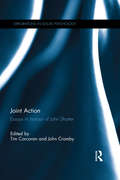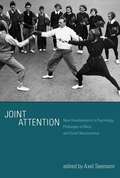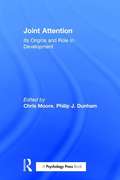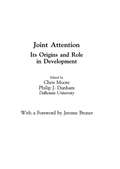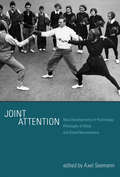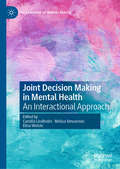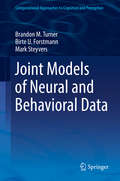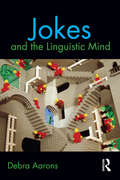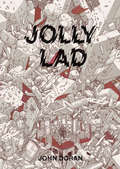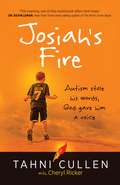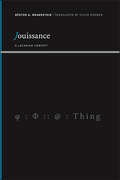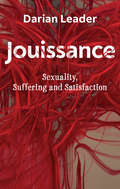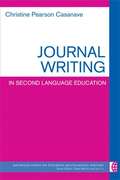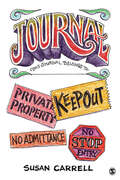- Table View
- List View
Johannes Kepler: Life and Letters
by Carola BaumgardtWith an introduction by Albert Einstein: The collected letters of the Renaissance astronomer who discovered the laws of planetary motion. Astronomer and mathematician Johannes Kepler made major contributions to the Scientific Revolution of the seventeenth century. While his achievements are well-documented elsewhere, this volume of his personal correspondence offers a rare window into the life of a man who pursued knowledge through a dangerous and turbulent period of history. Spanning more than thirty years, from 1596 to the end of his life, Kepler&’s letters reveal the internal conflicts of a devout Protestant who nevertheless opposed many pronouncements of the Church, an eminent man of science who was also swayed by astrology, and a contemporary of Galileo who served three succeeding Holy Roman Emperors.
John (TCG Edition)
by Annie BakerAn exploration of the science and history behind the violence of men explores the biological drives toward violence the role of organized fighting in teaching discipline and the author's own experiences with training as a mixed martial arts fighter By the award-winning author of The Storytelling Animal.
John Bowlby - From Psychoanalysis to Ethology
by Jerome Kagan Frank C. van der HorstThis accessible book draws on unique evidence from oral histories and little-known archive material to shed new light on the working relationships which led to John Bowlby's shift from psychoanalysis to ethology as a frame of reference - and ultimately to the development of attachment theory.A unique exploration of the origins of Bowlby's ideas and the critical transformation in his thinking - offers an alternative to standard accounts of the origin of attachment theoryExplores the significance of Bowlby's influential working relationships with Robert Hinde, Harry Harlow, James Robertson and Mary AinsworthProvides students, academics, and practitioners with clear insights into the development of attachment theoryAccessible to general readers interested in psychology and psychoanalysis
John Bowlby and Attachment Theory (Makers of Modern Psychotherapy)
by Jeremy HolmesSecond edition, completely revised and updated John Bowlby is one of the outstanding psychological theorists of the twentieth century. This new edition of John Bowlby and Attachment Theory is both a biographical account of Bowlby and his ideas and an up-to-date introduction to contemporary attachment theory and research, now a dominant force in psychology, counselling, psychotherapy and child development. Jeremy Holmes traces the evolution of Bowlby’s work from a focus on delinquency, material deprivation and his dissatisfaction with psychoanalysis's imperviousness to empirical science to the emergence of attachment theory as a psychological model in its own right. This new edition traces the explosion of interest, research and new theories generated by Bowlby’s followers, including Mary Main’s discovery of Disorganised Attachment and development of the Adult Attachment Interview, Mikulincer and Shaver’s explorations of attachment in adults and the key contributions of Fonagy, Bateman and Target. The book also examines advances in the biology and neuroscience of attachment. Thoroughly accessible yet academically rigorous, and written by a leading figure in the field, John Bowlby and Attachment Theory is still the perfect introduction to attachment for students of psychology, psychiatry, counselling, social work and nursing.
John Dewey: Science for a Changing World (History And Theory Of Psychology Ser.)
by Svend BrinkmannJohn Dewey was an American psychologist, philosopher, educator, social critic, and political activist. John Dewey: Science for a Changing World addresses Dewey's contemporary relevance; his life and intellectual trajectory; his basic philosophical ideas, with an emphasis on his philosophy of nature; and his educational theory, which has often been misunderstood. In addition, Dewey's pragmatism and pragmatist ethics are discussed, as are some of the criticisms that can be directed at them. Throughout the book, Dewey's ideas are related to the general history of ideas, but there is also a constant focus on how Dewey may assist us in solving some of the problems that face us in a so-called postmodern era. This book is the first to offer an interpretation of John Dewey's works with particular emphasis on his contribution to psychology. John Dewey distinguished himself by combining a culturalist approach to human life with a naturalistic one. He was an avowed naturalist and follower of Darwin, and Brinkmann shows how his non-reductionist, naturalist psychology can serve as a much-needed correction to contemporary forms of "evolutionary psychology." Dewey's psychology, however, is not an isolated element in his thinking as a whole, so the author also provides an introduction to the philosophical, ethical, and educational ideas that go hand-in-hand with his psychology. In the past couple of decades, there has been a renaissance of pragmatist ideas in philosophy, political theory, and education. Scholars are returning to the writings of William James, Charles Peirce, George Herbert Mead, and John Dewey. This book continues the fine tradition of Transaction's History and Theory of Psychology series.
John Kenneth Galbraith: His Life, His Politics, His Economics
by Richard ParkerThe life and times of America's celebrated economist, assessing his lessons-and warnings-for us today.John Kenneth Galbraith's books—among them The Affluent Society and American Capitalism—are famous for good reason. Written by a scholar renowned for energetic political engagement and irrepressible wit, they are models of provocative good sense that warn prophetically of the dangers of deregulated markets, war in Asia, corporate greed, and stock-market bubbles. Galbraith's work has also deeply-and controversially-influenced his own profession, and in Richard Parker's hands his biography becomes a vital reinterpretation of American economics and public policy.Born and raised on a small Canadian farm, Galbraith began teaching at Harvard during the Depression. He was FDR's "price czar" during the war and then a senior editor of Fortune before returning to Harvard and to fame as a bestselling writer. Parker shows how, from his early championing of Keynes to his acerbic analysis of America's "private wealth and public squalor," Galbraith regularly challenged prevailing theories and policies. And his account of Galbraith's remarkable friendship with John F. Kennedy, whom he served as a close advisor while ambassador to India, is especially relevant for its analysis of the intense, dynamic debates that economists and politicians can have over how America should manage its wealth and power. This masterful chronicle gives color, depth, and meaning to the record of an extraordinary life.
John Maynard Keynes and the Economy of Trust: The Relevance of the Keynesian Social Thought in a Global Society
by Donatella PaduaPadua has asked the question: How is it possible to build value via trust? She has answered through the construction of a compelling argument for the creation of a balanced global economy and a fairer distribution of wealth based upon that elusive quality of trust. - Garry Titterton, Tonjin University, Shanghai, Co-author Brand Storming.
Joined-Up Thinking: The Science of Collective Intelligence and its Power to Change Our Lives
by Hannah Critchlow'A lively examination of communal endeavour... important and correct' - Steven Poole, The GuardianAt a time of existential global challenges, we need our best brainpower to solve them.So how do we create genius environments, help our brains flourish and boost group thinking?Neuroscientist and bestselling author of The Science of Fate Hannah Critchlow shows how two heads can be better than one. Almost everything we've ever achieved has been done by groups working together, sometimes across time and space. Like a hive of bees, or a flock of birds, our naturally social, interconnected brains are designed to function best collectively.New technology is helping us share our wisdom and knowledge much more diversely across race, class, gender and borders. And AI is sparking a revolution in our approach to intelligent thinking - linking us into fast-working brain-nets for problem solving.Hannah Critchlow shows all the tricks to help us work best collectively - how to cope with wildly differing opinions, balance our biases, prevent a corrupting force, and exercise our intuitive ability for the most effective outcomes. She shares compelling examples of success, at work, in families, and all team situations, and shows us how to work, play and grow with intelligence.
Joined-Up Thinking: The Science of Collective Intelligence and its Power to Change Our Lives
by Hannah CritchlowSunday Times top ten bestselling author of The Science of Fate neuroscientist Hannah Critchlow brilliantly illuminates the new science of collective intelligence, showing how it can work to improve our lives and help solve the huge global challenges confronting us.At a time of existential global challenges we need our best brainpower to solve them. We can no longer rely on the myth of the lone genius to create a breakthrough.As neuroscientist and bestselling author of The Science of Fate Hannah Critchlow shows, two heads have always been better than one. Almost everything we've ever achieved has been done by groups of people working together, sometimes across time and space. Like a hive of bees, or a flock of birds, our naturally social, interconnected brains are designed to function best collectively.New technology is helping us share our wisdom and knowledge much more diversely across race, class, gender and borders. And AI is sparking a revolution in our approach to intelligent thinking -linking us into fast-working brainnets for problem solving.Hannah Critchlow brings us an enlightening, invaluable guide to our future through the evolving new science of collective intelligence. She reveals what it says about us as human beings, shares compelling examples and stories, and shows us how best we can work collectively at work, in families, in any team situation to improve our outcomes, our wellbeing, and our prospects. (P) 2022 Hodder & Stoughton Limited
Joining Together: Group Theory and Group Skills
by David W. Johnson Frank P. JohnsonJoining Together introduces readers to the theory and research needed to understand how to make groups effective and, through exercises and thorough explanations, equips them with the skills required to apply that knowledge to practical situations. Chapters discuss the history of groups and group dynamics, the nature of experiential learning, group goals, communication within groups, leadership, power, decision making, controversy and creativity, and conflict management. More applied chapters focus on valuing diversity, cooperative learning, leading counseling groups, and team development and training.
Joint Action: Essays in honour of John Shotter (Explorations in Social Psychology)
by Tim Corcoran John CrombyJoint Action: Essays in honour of John Shotter brings together a cross-disciplinary group of fifteen respected international scholars to explain the relevance of John Shotter’s work to emerging concerns in twenty-first century social science. Shotter’s work extends over forty years and continues to challenge conventional scientific thinking across a range of topics. The disciplines and practices that Shotter’s work has informed are well established throughout the English-speaking world. This is the first publication to examine the importance of his influence in contemporary social sciences and it includes authoritative discussions on topics such as social constructionism, democratic practice, organisational change, the affective turn and human relations. The geographical diversity and disciplinary breadth of scholarly contributions imbues the book with international scope and reach. Joint Action presents a contemporary reflection on Shotter’s work that demonstrates its influence across a range of substantive topics and practical endeavours and within disciplines including management studies and philosophy as well as psychology. As such, it will appeal to researchers and postgraduate students of social sciences and related disciplines, as well as to those who have heard of Shotter’s work and want to know more about its utility and value in relation to their own research or practice.
Joint Attention
by Axel SeemannAcademic interest in the phenomenon of joint attention-- the capacity to attend to an object together with another creature--has increased rapidly over the past two decades. Yet it isn't easy to spell out in detail what joint attention is, how it ought to be characterized, and what exactly its significance consists in. The writers for this volume address these and related questions by drawing on a variety of disciplines, including developmental and comparative psychology, philosophy of mind, and social neuroscience. The volume organizes their contributions along three main themes: definitional concerns, such as the question of whether or not joint attention should be understood as an irreducibly basic state of mind; processes and mechanisms obtaining on both the neural and behavioral levels; and the functional significance of joint attention, in particular the role it plays in comprehending spatial perspectives and understanding other minds. The collected papers present new work by leading researchers on one of the key issues in social cognition. They demonstrate that an adequate theory of joint attention is indispensable for a comprehensive account of mind.
Joint Attention: Its Origins And Role In Development
by Chris Moore Philip J. DunhamJoint attention to objects and events in the world provides the initial means whereby infants can start to share experiences with others and negotiate shared meanings. It provides a context for the development of both knowledge about the world and about others as experiencers. It plays a central role in the development of the young child's understanding of both the social and nonsocial worlds and in the development of the communicative interplay between child and adult. This volume explores how joint attention first arises, its developmental course, its role in communication and social understanding, and the ways in which disruptions in joint attention may be implicated in a variety of forms of abnormal development including autism.
Joint Attention: Its Origins and Role in Development
by Jerome Bruner Chris Moore Philip J. DunhamIt is perhaps no exaggeration to suggest that all of what is intrinsically human experience is grounded in its shared nature. Joint attention to objects and events in the world provides the initial means whereby infants can start to share experiences with others and negotiate shared meanings. It provides a context for the development of both knowledge about the world and about others as experiencers. It plays a central role in the development of the young child's understanding of both the social and nonsocial worlds and in the development of the communicative interplay between child and adult. The first devoted to this important topic, this volume explores how joint attention first arises, its developmental course, its role in communication and social understanding, and the ways in which disruptions in joint attention may be implicated in a variety of forms of abnormal development including autism.
Joint Attention: New Developments in Psychology, Philosophy of Mind, and Social Neuroscience (The\mit Press Ser.)
by Axel SeemannInterdisciplinary perspectives on definitional concerns, underlying mechanisms, and the functional significance of joint attention.Academic interest in the phenomenon of joint attention—the capacity to attend to an object together with another creature—has increased rapidly over the past two decades. Yet it isn't easy to spell out in detail what joint attention is, how it ought to be characterized, and what exactly its significance consists in. The writers for this volume address these and related questions by drawing on a variety of disciplines, including developmental and comparative psychology, philosophy of mind, and social neuroscience. The volume organizes their contributions along three main themes: definitional concerns, such as the question of whether or not joint attention should be understood as an irreducibly basic state of mind; processes and mechanisms obtaining on both the neural and behavioral levels; and the functional significance of joint attention, in particular the role it plays in comprehending spatial perspectives and understanding other minds. The collected papers present new work by leading researchers on one of the key issues in social cognition. They demonstrate that an adequate theory of joint attention is indispensable for a comprehensive account of mind.
Joint Decision Making in Mental Health: An Interactional Approach (The Language of Mental Health)
by Camilla Lindholm Melisa Stevanovic Elina WeisteThis volume studies joint decision making in mental health care contexts through an in-depth examination of the negotiations of power and authority at the level of turn-by-turn sequential unfolding of interaction. Bringing together research at the intersection of mental health, discourse and conversation analysis it examines a wide range of settings including chronic psychiatric visits, rehabilitation meetings, occupational therapy encounters and cognitive behavioral therapy appointments. It presents a series of studies which reveal in close detail the joint decision-making processes in these critical encounters by using naturally occurring video-recorded interactions from a range of health service settings as data. In so doing, it sheds light on the interactional practices of health care workers that may facilitate or discourage client participation in joint decision-making processes. The book will provide important insights for academics and practitioners working in the fields of psychology, psychotherapy, applied linguistics, nursing, social work and rehabilitation; and in particular for those specializing in psychiatry and mental health.
Joint Models of Neural and Behavioral Data (Computational Approaches to Cognition and Perception)
by Birte U. Forstmann Brandon M. Turner Mark SteyversThis book presents a flexible Bayesian framework for combining neural and cognitive models. Traditionally, studies in cognition and cognitive sciences have been done by either observing behavior (e.g., response times, percentage correct, etc.) or by observing neural activity (e.g., the BOLD response). These two types of observations have traditionally supported two separate lines of study, which are led by two different cognitive modelers. Joining neuroimaging and computational modeling in a single hierarchical framework allows the neural data to influence the parameters of the cognitive model and allows behavioral data to constrain the neural model. This Bayesian approach can be used to reveal interactions between behavioral and neural parameters, and ultimately, between neural activity and cognitive mechanisms. Chapters demonstrate the utility of this Bayesian model with a variety of applications, and feature a tutorial chapter where the methods can be applied to an example problem. The book also discusses other joint modeling approaches and future directions. Joint Models of Neural and Behavioral Data will be of interest to advanced graduate students and postdoctoral candidates in an academic setting as well as researchers in the fields of cognitive psychology and neuroscience.
Jokes and the Linguistic Mind
by Debra AaronsThrough the lens of cognitive science, Jokes and the Linguistic Mind investigates jokes that play on some aspect of the structure and function of language. In so doing, Debra Aarons shows that these 'linguistic jokes' can evoke our tacit knowledge of the language we use. Analyzing hilarious examples from movies, plays and books, Jokes and the Linguistic Mind demonstrates that tacit linguistic knowledge must become conscious for linguistic jokes to be understood. The book examines jokes that exploit pragmatic, semantic, morphological, phonological and semantic features of language, as well as jokes that use more than one language and jokes that are about language itself. Additionally, the text explores the relationship between cryptic crossword clues and linguistic jokes in order to demonstrate the difference between tacit knowledge of language and rules of language use that are articulated for a particular purpose. With its use of jokes as data and its highly accessible explanations of complex linguistic concepts, this book is an engaging supplementary text for introductory courses in linguistics, psycholinguistics and cognitive science. It will also be of interest to scholars in translation studies, applied linguistics and philosophy of language.
Jolly Lad (Strange Attractor Press Ser.)
by John DoranA memoir about the recovery from alcoholism, habitual drug use and mental illness, from broadcaster, and co-founder and editor of The Quietus website, John Doran.Jolly Lad is a memoir about the recovery from alcoholism, habitual drug use and mental illness. It is also about the healing power of music, how memory defines us, the redemption offered by fatherhood and what it means to be working class.&“This is not a 'my drink and drug hell' kind of book for several reasons—the main one being that I had, for the most part, had a really good time drinking. True, a handful of pretty appalling things have happened to me and some people that I know or used to know over the years. But I have, for the most part, left them out of this book as they are not illuminating, not edifying and in some cases concern other people who aren't here to consent to their appearance. Instead this book concentrates on what you face after the drink and the drugs have gone.&”Jolly Lad is about gentrification; being diagnosed bipolar; attending Alcoholics Anonymous; living in a block of flats on a housing estate in London; the psychological damage done by psychedelic drugs; depression; DJing; factory work; friendship; growing old; hallucinations; street violence and obsessive behaviour—especially regarding music and art.
Jordi
by Theodore Isaac RubinThe main endeavor of the book is to convey the feeling, panic, suffering, and tragedy involved in mental disturbance and more explicitly in childhood schizophrenia.
Josiah's Fire: Autism Stole His Words, God Gave Him a Voice
by Cheryl Ricker Tahni CullenWhere is hope when there is no hope? First-time parents Joe and Tahni Cullen were thrust into the confusing world of autism when their toddler, Josiah, suddenly lost his ability to speak, play, and socialize. The diagnosis: Autism Spectrum Disorder. In their attempts to see Josiah recover and regain speech, the Cullens underwent overwhelming physical, emotional, and financial struggles. While other kids around him improved, Josiah only got worse. Five years later, Josiah, who had not been formally taught to read or write, suddenly began to type on his iPad profound paragraphs about God, science, history, business, music, strangers, and heaven. Josiah's eye-opening visions, heavenly encounters, and supernatural experiences forced his family out of their comfort zone and predictable theology, catapulting them into a mind-blowing love-encounter with Jesus. Find hope in hardship. Catch a fresh glimpse of heaven. Learn to hear and trust God's voice. Identify the roles of Father, Son, and Spirit. Be aware of the workings of angels, and much more! Follow a trail of truth into Josiah's mysterious world, and see why his family and friends can no longer stay silent.
Jouissance: A Lacanian Concept (SUNY series, Insinuations: Philosophy, Psychoanalysis, Literature)
by Néstor A. BraunsteinWhether inscribed within the context of capitalist or neoliberal logic and its imperative to "enjoy," as a critique of all forms of heteronormativity, a liberating force in a positive reading of biopolitics, the point of inflection in the ethics of psychoanalysis, or articulated in the knot of the sinthome, the concept of jouissance is either the diagnosis, response, or solution for a wide range of contemporary discontents. Why does jouissance occupy such a central place in contemporary psychoanalytic discourse? What is jouissance the name for? Originally published in Spanish in 1990, later expanded and translated into French and Portuguese, with multiple reprints in all three languages, this book addresses both theoretical and clinical applications of jouissance through a comprehensive overview of key terms in Lacan's grammar. Néstor A. Braunstein also examines it in relation to central debates within the fields of psychoanalysis, philosophy, queer theory, and literary studies to further explore the implications of Lacan's concept for contemporary thought.
Jouissance: Sexuality, Suffering and Satisfaction
by Darian LeaderAlthough the term 'jouissance' is common currency in psychoanalysis today, how much does it really tell us? While often taken to designate a fusion of sexuality, suffering and satisfaction, the term has fallen into a purely descriptive use that closes down more questions than it opens up. Although assumed to explain the coalescence of pleasure and pain, it tends to cover a range of quite different issues that should be distinguished rather than conflated. By returning to some of the sources of the concept in Freud, and their elaborations in Lacan, this book hopes to stimulate a debate around the relations of pleasure to pain, autoerotism, the links of satisfaction to arousal, the effects of repression, and the place of the body in psychoanalytic theory. Leader aims to provide context for Lacan's work and encourage dialogue with other analytic traditions.
Journal Writing in Second Language Education
by Christine Pearson CasanaveJournal writing is not new--journals have been around for centuries. More recently, journals have been viewed as a means of scaffolding reflective teaching and encouraging reflectivity in research processes. As a result, some educators may ask, “What more do we need to know?” Those likely to raise this question are probably not thinking of the explosive growth of reflective writing enabled by social networking on the Web, the blogs and other interactive e-vehicles for reflection on experiences in our literate, “real,” and virtual lives This revisiting of journal writing from a 21st century perspective, informed by relevant earlier literature, is what Christine Pearson Casanave guides readers through in this first book-length treatment of the use of journal writing in the contexts of language learning, pre and in-service teaching, and research. Casanave has put together existing ideas that haven't been put together before and has done it not as an edited collection, but as a single-authored book. She has done it in a way that will be especially accessible to teachers in language teacher education programs and to practicing teachers and researchers of writing in both second and foreign language settings, and in a way that will inspire all of us to think about, not just do, journal writing. Those who have never attempted to use journals in their classes and own lives, as well as others who have used it with mixed results, will probably be tempted to try it in at least some of the venues Casanave provides guidance for. Those already committed to journal writing will very likely find in this book new reasons for expanding and enhancing their use of journals.
Journal: A Guide to Self-Discovery and Growth
by Susan E. CarrellEmbark on a voyage of self-discovery and growth Paired with Group Exercises for Adolescents, this resource enhances experiences in group work as participants discover the art of journaling. They′ll find these helpful tools:21 structured writing exercises for personal reflection and group discussionsCartoons and drawings Blank, lined pages to record thoughts, feelings, and ideas"My Doodles" pages to encourage artistic self-expressionTeens Journal Too!Journaling isn′t just for adults. Many teens and pre-teens chronicle their lives and express themselves through journaling. They lament relationships gone wrong, fume about unjust treatment at the hands of parents and other authority figures, and celebrate victories both in and out of school. In the language of teens, they "get their feelings out", a proven benefit to emotional well-being. Unlike the ordinary blank-paged journals found in book stores and gift shops everywhere, this teen journal is carefully crafted by an expert in adolescent therapy. In addition to plenty of blank pages for self-expression, there are questions to ponder and answer that promote self-discovery and growth. Appealing cartoons and "Doodle Pages" make the journal come alive. The savvy eleven-year-old, defiant fourteen-year-old and shy sixteen-year-old will be intrigued and challenged. "Journal: A Guide to Self-Discovery and Growth" may be an adolescent′s best friend.Parents, aunts, cousins, friends and others who are looking for a present for graduation (from elementary or middle school), birthdays, religious rites of passage, Christmas and other religious holidays, as well as occasional gifts of encouragement or celebration will be delighted to find and purchase the Journal. And of course, teens will buy it themselves, for themselves!
